Uncategorized
Equity Bank Plan Sh7.6b Staff Share Reward Scheme
Published
11 months agoon
By
adminEquity Group has announced the revival of its employee share ownership plan (Esop) in an effort to retain and attract talented staff. The bank plans to distribute 198.6 million shares, valued at Sh7.6 billion, to employees over the next 10 years. This comes after a previous attempt four years ago to implement a similar plan, which was abandoned just before the allotment of 205.7 million shares in 2019.
Equity Group’s board has proposed the creation of additional shares to support the Esop and will seek shareholder approval during the upcoming annual general meeting on June 28.
The newly created shares will amount to five percent of the company’s share capital, raising the maximum share capital from Sh1.886 billion to Sh1.986 billion. The directors will have the flexibility to issue the additional shares in tranches and based on terms and conditions they deem appropriate.
Notably, the Group’s CEO, James Mwangi, is among the employees expected to benefit from the share allotment. The previous Esop plan in 2019, which was withdrawn during the AGM, would have allocated 205.7 million shares worth Sh8.4 billion to bank staff.
This new Esop will be the second of its kind for Equity Group, as the bank initially established a stock-based compensation scheme before its listing on the Nairobi Securities Exchange in 2006. Esops are employee benefit plans that provide ownership interest in the company through shares. They are designed to enhance staff productivity, reward employees, and attract and retain talent. The approval of the Capital Markets Authority (CMA) is required for the implementation of Esops. According to the CMA, as of March 2021, it had approved 14 Esops.
You may like
Welcome to WordPress. This is your first post. Edit or delete it, then start writing!
Uncategorized
Fish kills leave Kenya’s Lake Victoria farmers at a loss, seeking answers
Published
11 months agoon
June 18, 2023By
admin- According to a Kenyan government report, fish farmers in sections of Lake Victoria lost more than 900 million Kenyan shillings ($7.2 million) in massive fish kills in November 2022.
- Scientists attribute the fish kills to reduced levels of dissolved oxygen likely due to a natural phenomenon called upwelling, which can be exacerbated by climate change and extreme weather.
- Local farmers who lost their fish, however, attribute the die-offs to pollution from Lake Victoria industries, which agencies have accused of discharging untreated effluent into the lake in recent years.
KISUMU, Kenya — It is a little past 5 p.m. at the lakeside city of Kisumu, in the western part of Kenya. An hour later, the sun sets over the sprawling Lake Victoria as far as the eye can see. Wisps of gray clouds are infused with the sun’s amber rays, which reflect off the lake in a bedazzling shimmer. The scene is captivating, but a faint stench lingers in the air. That stench, to many cage fish farmers, is a painful reminder of the extensive losses they suffered in November 2022 due to fish kills.
A report commissioned by Kenya’s State Department for Fisheries, Aquaculture and the Blue Economy estimates that cage farmers in different sections of Lake Victoria, particularly Kisumu and Homa Bay towns, lost more than 900 million shillings ($7.2 million) to fish kills in 2022. While the scientists Mongabay speaks to attribute the fish kills to a combination of natural phenomena and climate change, the fish farmers are wary of those explanations, saying the deaths could be a result of pollution.
Fish farmers in Lake Victoria mainly stock tilapia (Oreochromis niloticus), which, according to scientists, are preferred due to their fast growth, resistance to disease and ability to withstand low dissolved oxygen levels. Tilapia and Nile perch (Lates niloticus) are the two most abundant fish species in the lake, and tilapia is more profitable in the local market.
Two of the fish farms, Kentila Farms and Lake Aqua Limited, suffered the greatest losses: 200.4 million shillings ($1.6 million) and 138 million shillings ($1.1 million), respectively, according to the government report. Although the fish kills happened in November, the memories of the losses are still fresh in people’s minds months later.
At Ogal Beach, the section of the lake where farmers were worst hit, there is a flurry of activity as fishers return from early morning fishing expeditions. They are gradually easing back into their routines. It is not until you engage the fishers that you begin to understand the hurt some of them bear beneath the apparent normalcy.
“I do not want to talk to the media anymore. … Nothing comes out of it! It is like opening an old wound that I would rather forget,” says Jacob Okomo, a fish farmer at Ogal Beach who deals in tilapia. It is unclear how much loss he suffered, since he does not talk about what happened.
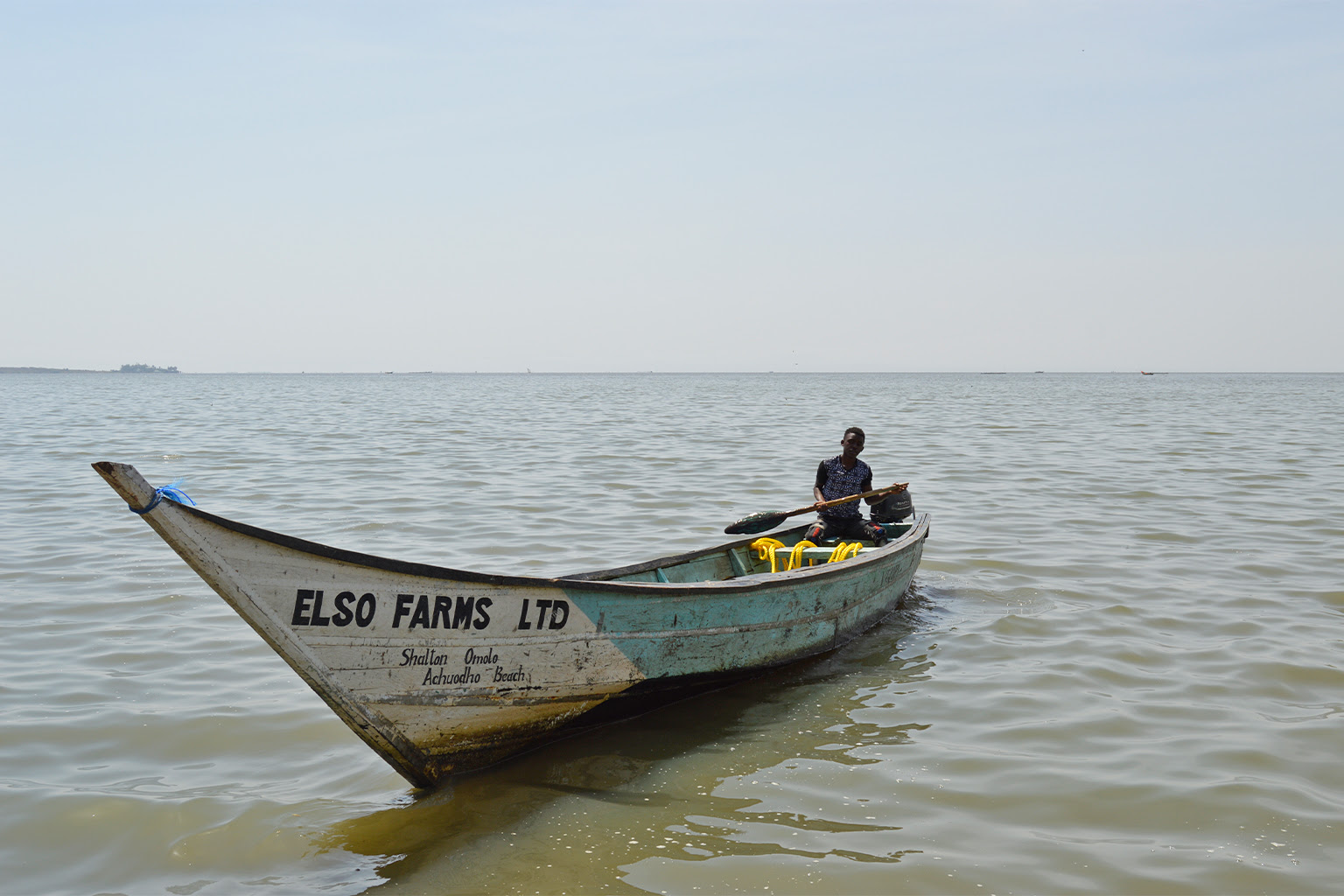 Shalton Omolo’s assistant rowing Omolo’s boat. Most fish farmers in Kisumu use similar boats. Image by Calvin Rock Odhiambo for Mongabay.
Shalton Omolo’s assistant rowing Omolo’s boat. Most fish farmers in Kisumu use similar boats. Image by Calvin Rock Odhiambo for Mongabay.
Low levels of dissolved oxygen can kill fish
Many of the fish farmers lost their fish to massive die-offs usually attributed to reduced levels of dissolved oxygen (DO) in water — a phenomenon that commonly results in what is referred to as fish kills.
According to a review article published in the journal Fisheries Management and Ecology, Lake Victoria fish kills in recent years have been attributed to reduced dissolved oxygen content in the water. The article, which references incidents in 2016 at two other beaches on the lake — Anyanga and Nyenye-Got — notes a number of reasons for reduction in oxygen levels, including poor water circulation in the cages due to algae and feed residues as well as possible upwelling around the cages.
“Upwelling [occurs] when the water at the bottom [of the lake] rises, and the water at the bottom of the lake or sea is usually low in oxygen,” says Chrispine Nyamweya, a researcher at the Kenya Marine and Fisheries Research Institute (KMFRI). Nyamweya, who specializes in limnology (the study of inland aquatic ecosystems), explains that processes like decomposition, which uses oxygen, cause deficiency in the bottom column of water, which rises to the top during upwelling.
“When there is wind action or changes in water temperature, which changes the densities, water from the bottom rises up to the surface in the process … killing fish because of suffocation,” Nyamweya says. “Upwelling occurs at predictable times of the year but sometimes because of climate change and extreme weather conditions, these events happen at places and times we don’t expect.”
 A fisher repairs his fishing net at Achodho Beach in Kisumu County. Image by Calvin Rock Odhiambo for Mongabay.About half a kilometer across from Ogal Beach is Achuodho Beach. Shalton Omolo, a cage farmer who deals in tilapia, says he lost more than 4 million shillings ($32,000) to fish kills in November. He started ELSO farms in 2019; using proceeds from aquaculture, he invested in beekeeping and goat rearing, selling honey and goat meat to boost his income. Unlike Okomo, he is willing to talk about his experience of discovering dead fish in their cages. He speaks with passion, recalling the Friday it happened.
A fisher repairs his fishing net at Achodho Beach in Kisumu County. Image by Calvin Rock Odhiambo for Mongabay.About half a kilometer across from Ogal Beach is Achuodho Beach. Shalton Omolo, a cage farmer who deals in tilapia, says he lost more than 4 million shillings ($32,000) to fish kills in November. He started ELSO farms in 2019; using proceeds from aquaculture, he invested in beekeeping and goat rearing, selling honey and goat meat to boost his income. Unlike Okomo, he is willing to talk about his experience of discovering dead fish in their cages. He speaks with passion, recalling the Friday it happened.
“We woke up very early, prepared to harvest because we had a lot of orders and clients were waiting for us in town and some were waiting for us at the beach,” Omolo says. “When we were about to arrive at the farm [fish cages] we were met by some funny smell, but we assumed everything was OK.”
Upon arrival, Omolo says, he and his assistants found thousands of fish floating in the water inside the cages. He was forced to call his customers, mostly hoteliers, informing them of what had happened. He had no option but to refund the money some of them had already paid.
“At first I thought it was foul play; I thought it was a human act because I had advertised and people [customers] were really waiting on their orders. I thought somebody might have poisoned the fish,” Omolo says. “I mostly deal with hotels and Fridays are good days because we are heading to the weekend so sales are really good and hotels want their fish supplied as early as possible — latest 7 a.m.”
Omolo says he later found out that other fish farmers in other areas of the lake had also been affected. He then realized the fish could have died from natural causes, although he remains skeptical.
 Shalton Omolo steering his boat offshore. Image by Calvin Rock Odhiambo for Mongabay.Things have not been easy for Omolo, who has two school-going children and siblings who depend on him. Even though he is slowly getting back on his feet, he says he is still burdened by the uncertainty of what the future holds.
Shalton Omolo steering his boat offshore. Image by Calvin Rock Odhiambo for Mongabay.Things have not been easy for Omolo, who has two school-going children and siblings who depend on him. Even though he is slowly getting back on his feet, he says he is still burdened by the uncertainty of what the future holds.
“By the time I lost my fish, all the fish were ready for harvest and I had 80,000 pieces of fish [individual fish]. The total stock was amounting to 3 million shillings ($23,000); when the government did their calculation it was amounting to 4.6 million (just over $35,000) because of other factors left out during my calculation,” he says.
The cost of constructing a cage of 6-by-6-by-4 meters (20-by-20-by-13 feet) is about 400,000 shillings ($3,000), Omolo says, without factoring in the cost of fish fingerlings, which cost 4 shillings ($0.03) each. He also fed the fish twice daily at a cost of 100,000 ($800) shillings per cage, until the fish were ready for market. At the time he lost the fish, he had 12 cages.
Ironically, aquaculture was introduced to Lake Victoria as a lucrative alternative to fish hunting while also solving the problem of dwindling fish volumes in the lake. However, with the losses farmers incurred, many are wondering whether it is worth the investment.
A report published in the International Journal of Fisheries and Aquatic Studies, which focuses on fish kills in Lake Naivasha in February 2010, notes that suffocation as a result of oxygen depletion is “often” the cause of fish kills. Further, the report highlights “natural causes” such as “climatic conditions that can lead to deoxygenation of the water, diseases, stress, toxic algae, thermal shock and salinity shock among other factors.”
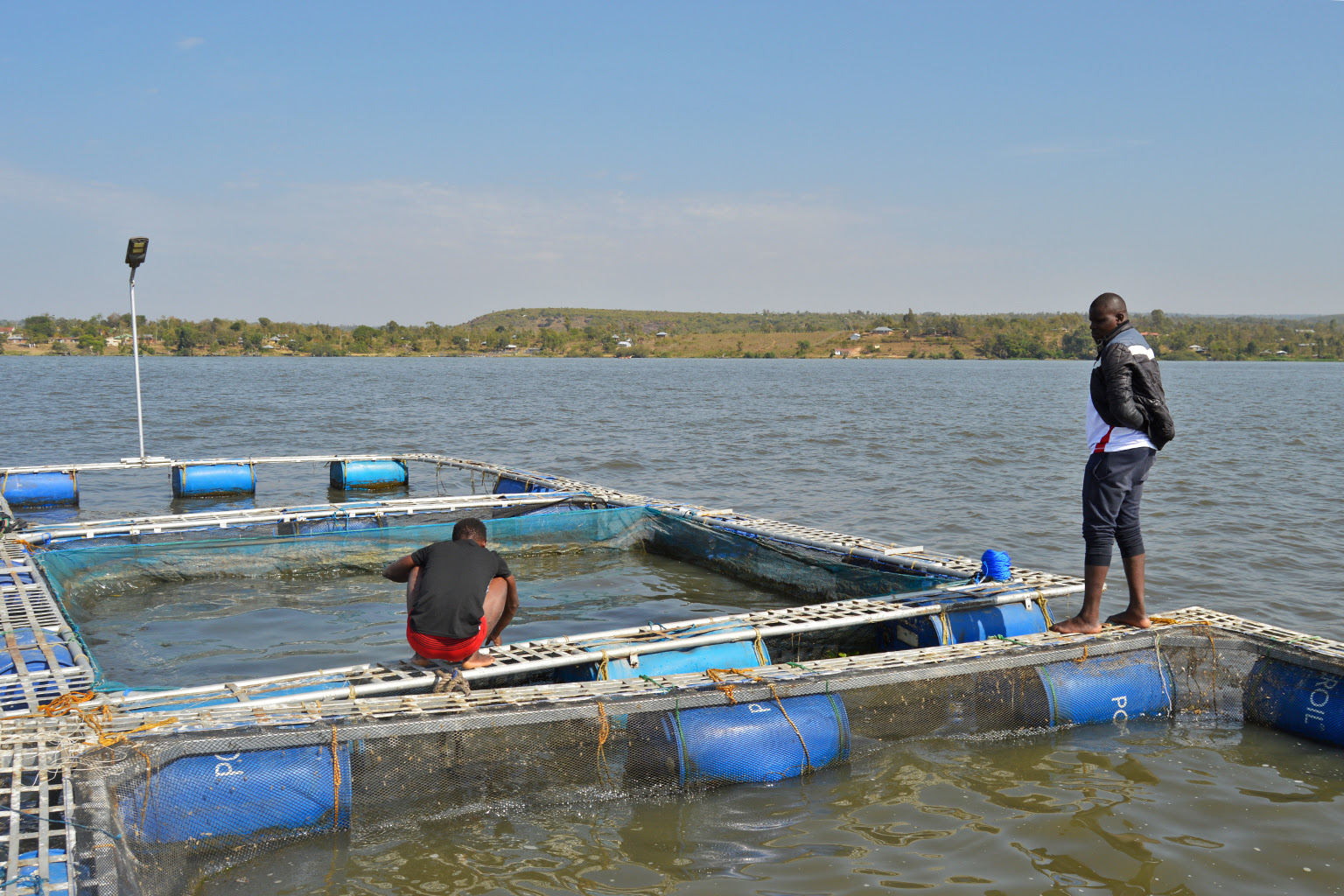 Omolo’s assistant and Omolo inspecting the fish nets. Image by Calvin Rock Odhiambo for Mongabay.Omolo, however, suspects there could be more to the fish kills than just “natural cause,” which, he says with skepticism, the scientists from KMFRI refer to as “an act of God.”
Omolo’s assistant and Omolo inspecting the fish nets. Image by Calvin Rock Odhiambo for Mongabay.Omolo, however, suspects there could be more to the fish kills than just “natural cause,” which, he says with skepticism, the scientists from KMFRI refer to as “an act of God.”
“Everybody knows what happened. Things like ‘natural phenomena,’ things like ‘upwelling,’ people are just trying to hang onto them — those are jargons to me but we know very well what really affected the lake and what is killing the fish,” Omolo says. “What is happening is: We are losing our fish due to the pollution in the lake.”
He points a finger at companies around the Lake Victoria Basin accused of discharging effluents into the lake. His sentiments are echoed by Okomo and Michael Nyaguti, an environmentalist based in Kisumu, both of whom blame the die-offs on pollution. According to them, a discoloration on some sections of the lake is clear evidence of pollution. Nyaguti describes the color as that of “strong [black] tea.”
In 2020, Chris Kiptoo, who was then principal secretary of environment and forestry, singled out institutions and industries complicit in polluting Lake Victoria to Kenya’s environment watchdog, the National Environment Management Authority (NEMA), saying that 102 companies from 14 counties were responsible. In March 2022, NEMA said it would shut down 13 facilities for discharging untreated effluent into the water. As of publication, NEMA has not responded to Mongabay’s request for comment and an update on the situation.
Nevertheless, Susan Adhiambo, the Kisumu County director of fisheries, is quick to dispute the allegations that the November fish kills were caused by extensive pollution.
“If it was pollution, it would have happened in the whole lake. … These deaths were sporadic at specific points, and there is no evidence that there is pollution taking place at those points. So I cannot clearly say it was pollution without sound evidence to prove [it].”
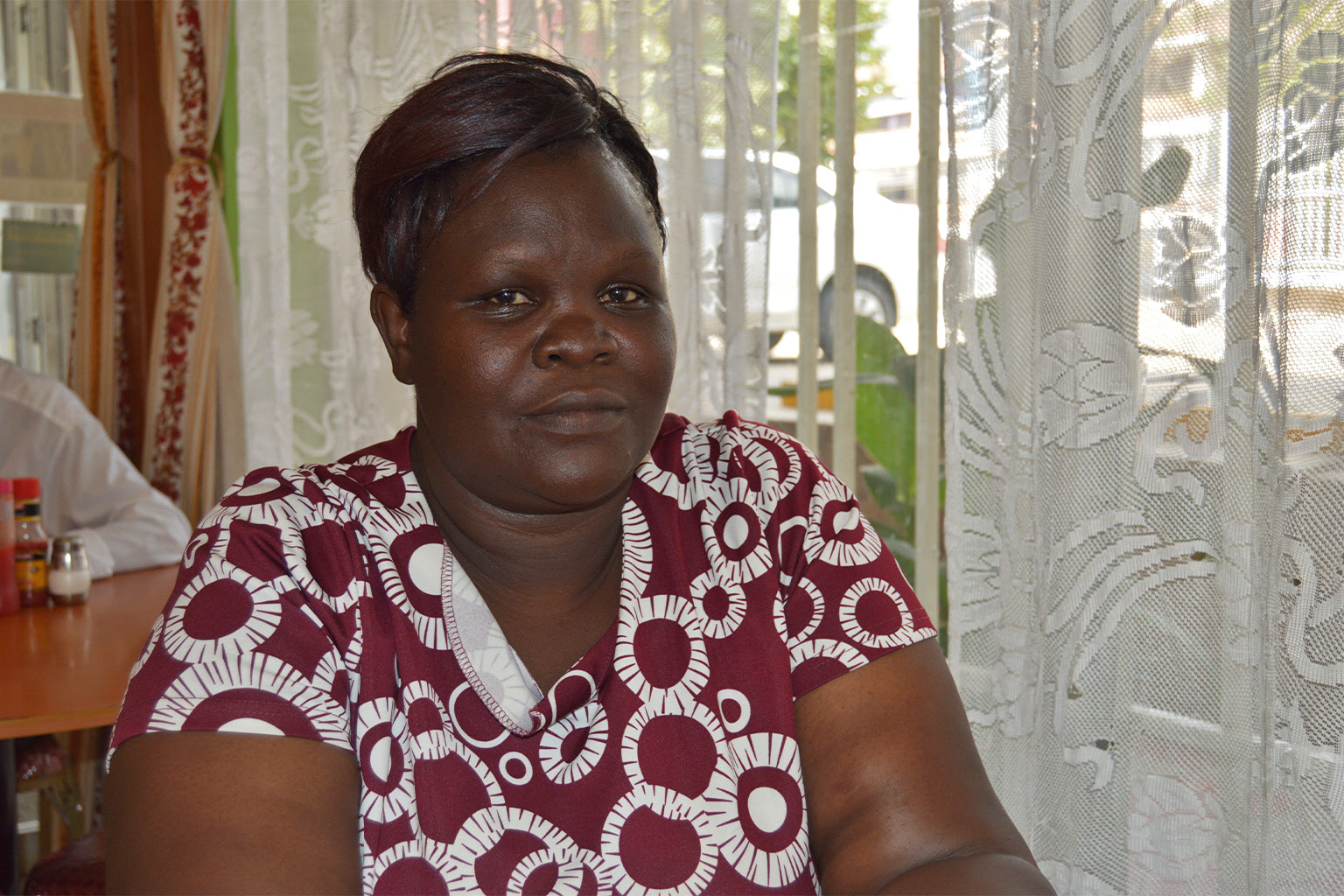 Susan Adhiambo, the Kisumu County director of fisheries. Image by Calvin Rock Odhiambo for Mongabay.
Susan Adhiambo, the Kisumu County director of fisheries. Image by Calvin Rock Odhiambo for Mongabay.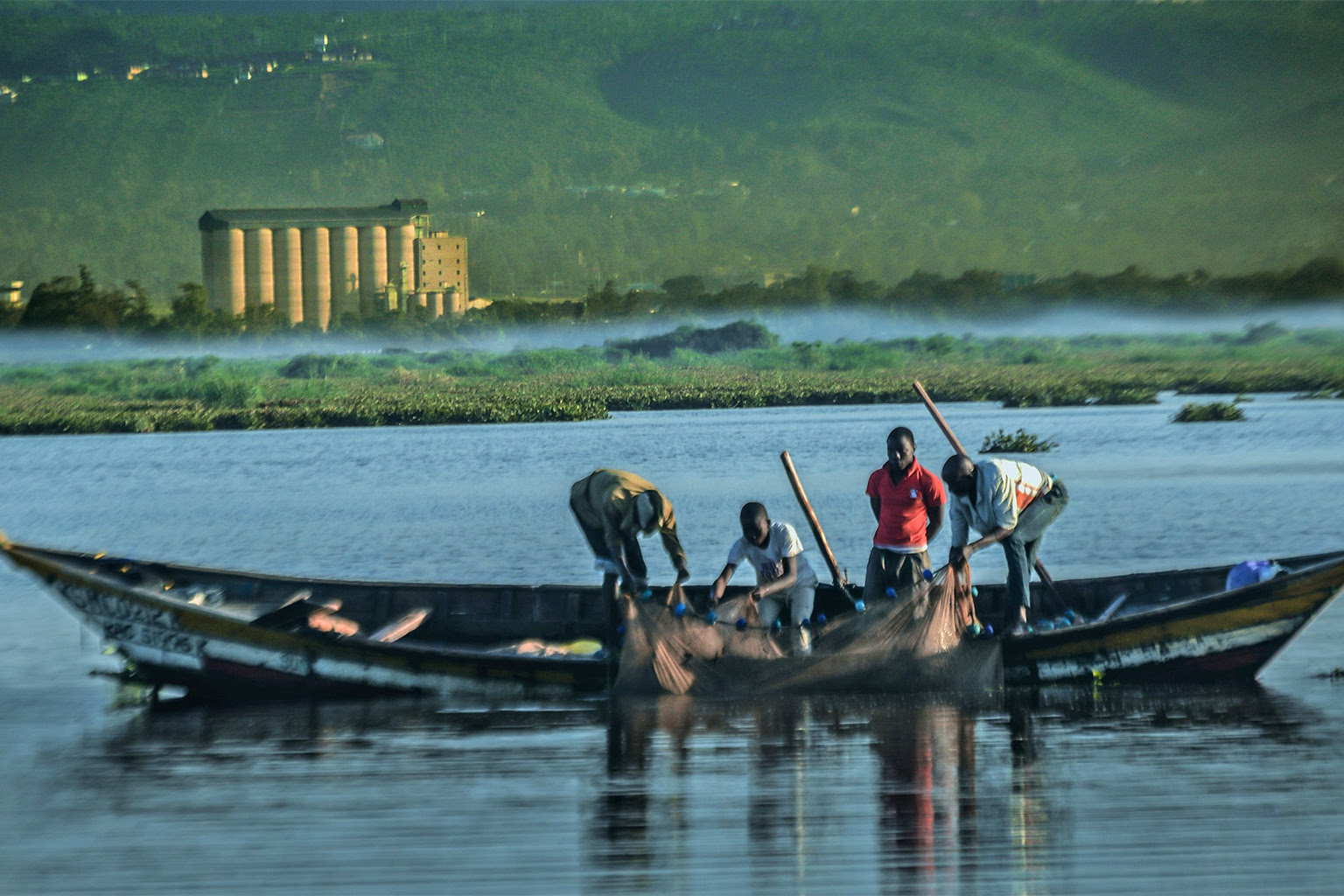 Fishermen gathering their catch early in the morning on Lake Victoria. An industrial unit at the lake’s banks can be seen in the background. Image by Franklin Amulyoto via Wikimedia Commons (CC BY-SA 4.0).She backs upwelling as the cause of the fish kills as indicated by researchers and scientists from the government. “[Upwelling] can be predictable, but with climate change, there are so many changes … even temperature patterns are changing, so it is becoming unpredictable,” Adhiambo says.
Fishermen gathering their catch early in the morning on Lake Victoria. An industrial unit at the lake’s banks can be seen in the background. Image by Franklin Amulyoto via Wikimedia Commons (CC BY-SA 4.0).She backs upwelling as the cause of the fish kills as indicated by researchers and scientists from the government. “[Upwelling] can be predictable, but with climate change, there are so many changes … even temperature patterns are changing, so it is becoming unpredictable,” Adhiambo says.
She adds that not all regions of the lake are suitable for cage farming, and that overcrowding the lake with fish cages may contribute to pollution.
Like Adhiambo, Nyamweya says the fish cages were most likely set up in areas unsuitable for fish farming, and that could have been the greatest contributor to the fish kills. He says that while pollution may also cause reduced levels of oxygen in the lake, it is unlikely that it was the cause of the November 2022 fish kills as many more fish farms across the lake would have been affected.
“I can say for certain that these fish kills were as a result of overcrowding and being set up in unsuitable areas.”
Despite Nyamweya and Adhiambo’s stand, Nyaguti, who is the founder of Magnam Environmental Network, a pro-conservation community-based organization, says pollution is largely to blame.
 Shalton shares a light moment with Michael Nyaguti. Nyaguti runs a pro-conservation CBO called Magnum Environment Network. Image by Calvin Rock Odhiambo for Mongabay.“[T]hey were saying it is because of climate change issues and therefore they could not control it,” Nyaguti says, “but we still call for more research because much as we have water hyacinth rotting … we are aware that a lot of pollutants are still entering into the lake.”
Shalton shares a light moment with Michael Nyaguti. Nyaguti runs a pro-conservation CBO called Magnum Environment Network. Image by Calvin Rock Odhiambo for Mongabay.“[T]hey were saying it is because of climate change issues and therefore they could not control it,” Nyaguti says, “but we still call for more research because much as we have water hyacinth rotting … we are aware that a lot of pollutants are still entering into the lake.”
At the moment, scientists can only present the most likely causes of the fish kills. It could have been a combination of many things, including drought, which, according to the report in the International Journal of Fisheries and Aquatic Studies, also causes fish kills.
Nonetheless, fish farmers like Omolo and Okomo have suffered massive losses. Their hope is that the Kisumu county government, together with the national government, will implement the recommendations proposed by a task force investigating the fish kills — particularly, offering financial and psychosocial support to the affected farmers. Yet, more importantly, they say, scientists should conduct more research and come up with ways to prevent fish kills in the future — for this remains their greatest fear.
Mogabay
Uncategorized
Drying wetlands and drought threaten water supplies in Kenya’s Kiambu County
Published
11 months agoon
June 18, 2023By
admin- Prolonged drought in Kenya has caused a water crisis, threatening local livelihoods and biodiversity; one of the badly affected areas is Kiambu County, a region normally known for its high agricultural productivity.
- Human activities such as dumping, encroachment and overgrazing coupled with dire effects of climate change exacerbate the degradation of wetlands, worsening the water crisis.
- Scientists say that conservation efforts must center around local communities to ensure the restoration of natural resources and combat the impacts of climate change.
LIMURU, Kenya — Kiambu County in Kenya is facing a major water scarcity crisis that is threatening not only people’s livelihoods but also biodiversity. Rivers and wetlands that were once roaring with life are now dry and barren. With prolonged drought worsening the situation, residents are worried about the long-term implications and the drastic decrease in water supply over the last few years. Of particular concern is the Manguo swamp, a wetland that is not only a source of water for the community but also a rich harbor for biodiversity, which has, for the first time since the residents can remember, totally dried up.
Kiambu county, located in central Kenya, is the second most populous county in the country. It is located north of the capital, Nairobi, and is known for its lush greenery and rich fertile lands famous for Irish potatoes, cabbages, pears and other horticultural crops, supplying a large extent of Nairobi’s food needs.
Many residents are worried about news of drying rivers and boreholes, drilled by homeowners and the government to locate water, plus a looming local water crisis.
The Manguo swamp — or what used to be — sits near Limuru town, about 40 kilometers (25 miles) from Nairobi. Along the Nairobi-Nakuru highway, at the junction with Kiambu Road, is a barren depression about seven football fields long and four football fields across. Herders and their flocks of sheep are scattered across the desert-like depression, with only countable patches of green grass remaining. One of the herders is 65-year old James Njuguna, who was born and raised here.
“This is the Manguo swamp you’ve heard about,” says Njuguna. “It is now totally dry!”
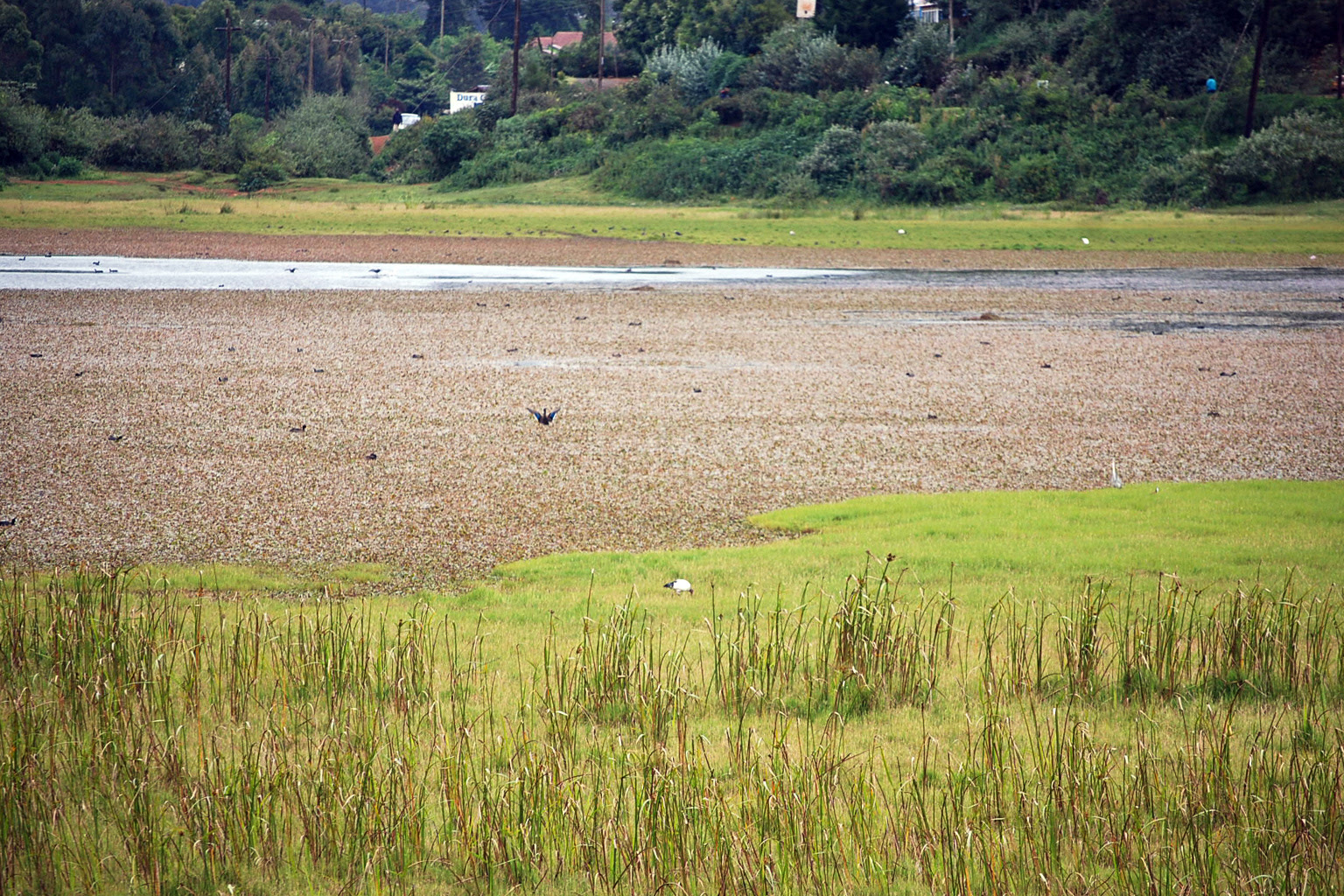 The Manguo swamp a few years ago. Image courtesy of Jane Macharia.
The Manguo swamp a few years ago. Image courtesy of Jane Macharia. The Manguo swamp now is a desert-like depression, with only countable patches of green grass remaining. Image by Calvin Rock Odhiambo/Mongabay.Online images of Manguo swamp from 2017 depict a picturesque marshy wetland harboring ducks, herons, crested cranes and a variety of other birds and wildlife. Now, the water and vegetation are gone, with hardly any birds or wildlife in sight. Manguo swamp was a 30-hectare (74-acre) wetland, but what is left of it is a water-starved area with dusty footpaths criss-crossing through it.
The Manguo swamp now is a desert-like depression, with only countable patches of green grass remaining. Image by Calvin Rock Odhiambo/Mongabay.Online images of Manguo swamp from 2017 depict a picturesque marshy wetland harboring ducks, herons, crested cranes and a variety of other birds and wildlife. Now, the water and vegetation are gone, with hardly any birds or wildlife in sight. Manguo swamp was a 30-hectare (74-acre) wetland, but what is left of it is a water-starved area with dusty footpaths criss-crossing through it.
“I have lived here for 65 years and never have I ever witnessed Manguo [swamp] this dry. During droughts, the swamp dries up but the center usually retains some water,” Njuguna says.
Ironically, during some rainy seasons — particularly during the long rains between April and June — the swamp floods, forcing residents to dig outlet channels. At full capacity, water rises to a depth of about 6 feet. “During rainy seasons, it is impossible to get in here. We would be submerged in the water now,” Njuguna says. According to him, the swamp has never been passable before. But now, cracks on the dry floor are the only evidence that it once had water.
Njuguna’s family used to rely on water from the swamp for domestic and livestock purposes, but that changed 25 years ago when they got access to tapped water. According to him, many local residents cannot afford to install piped water supplied by the government-run Limuru Water and Sewerage Co. Ltd. Nonetheless, he says, the water bills are higher now since he has to give the tapped water to his more than 100 sheep, which previously would drink from Manguo swamp. Normally, he and his family use 6 cubic meters (about 1,600 gallons) of water per month at a cost of 480 shillings ($3.7), but now he pays at least five times this. He says this has substantially affected his income from selling sheep. Njuguna tells Mongabay that many residents of Limuru in Kiambu county depend on water from boreholes, many of which are also drying up.
Satellite images of the Manguo swamp in 2017 and 2022. Images by Google Earth.
A 2011 study, published in the journal Biodiversity, focused on the management of highland wetlands in Kenya, using Manguo and Ondiri swamps as case studies. According to the study, human activities such as dumping of solid waste, encroachment, agriculture, overexploitation and overgrazing were listed as major threats to the wetlands. Jane Macharia, a research scientist at the National Museums of Kenya and lead author of the study, says these problems have persisted and have been made worse by climate change. Kenya is currently witnessing a drought reported to be the worst in 40 years, leaving a number of the country’s wetlands dry. Lake Ol Bolossat is one such wetland that, like Manguo, has dried up.
“While it is surprising [the drying of Manguo swamp], it is something that cuts across the country,” Macharia says. With the long rains through June, she says, “most rivers and wetlands will recover, but I think that should not be comforting; we have to take steps towards measures to restore our [water] catchment areas.”
But, according to her, local communities can lack trust in conservationists, and are thus reluctant to support efforts to conserve wetlands. Most conservation projects, being donor-funded and periodic, can lead local communities to doubt their legitimacy when they end without a clear long-term solution. Nevertheless, Macharia says, she believes conservation initiatives that include genuine partnership with community members, communication, education, public participation and awareness will be successful.
“If you are made to know the need to do something, you will do it freely. You will engage in good practices freely,” she says.
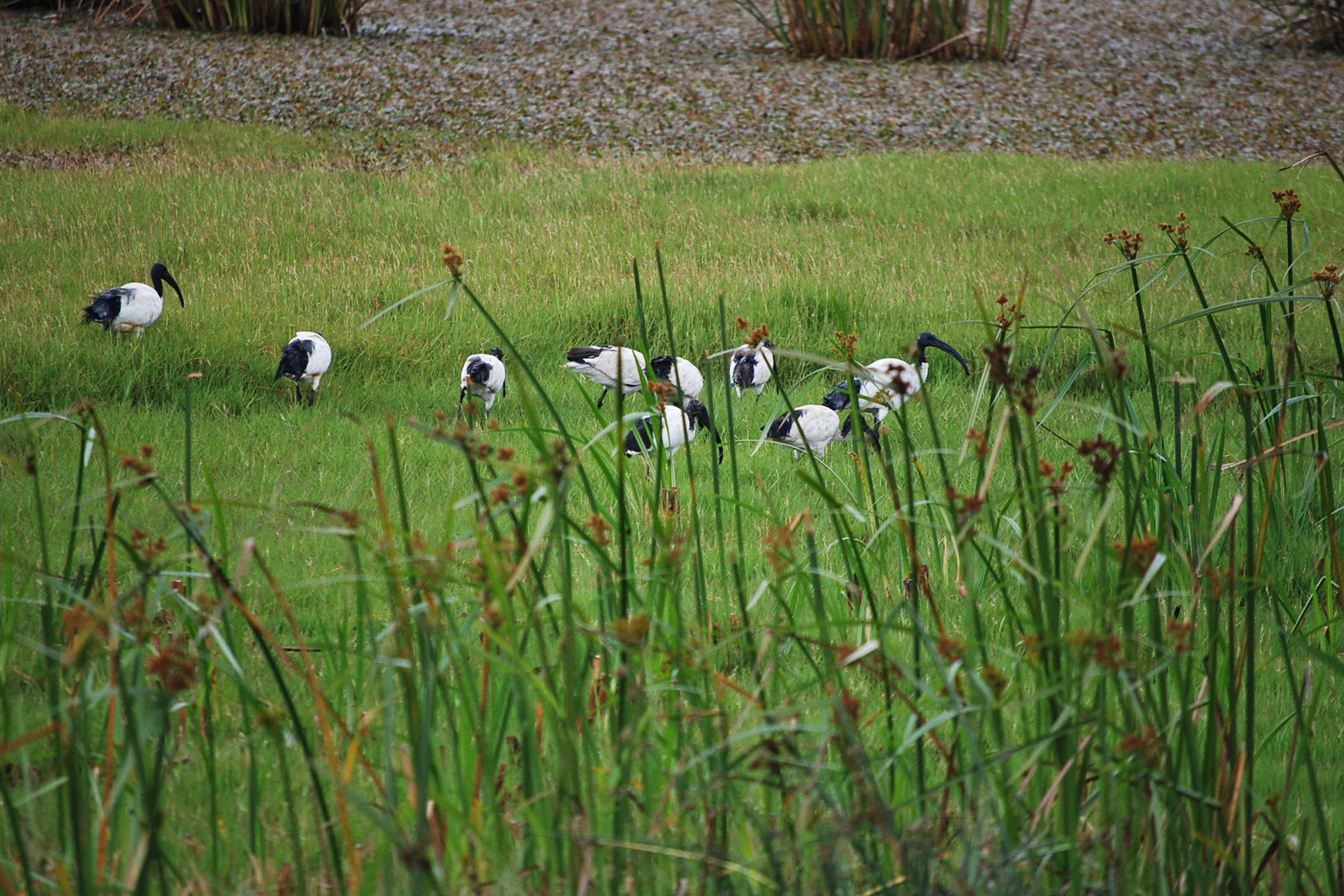 Black-headed ibises (Threskiornis melanocephalus) at a grassy section of Manguo wetland in 2009. The swamp is a rich harbor for biodiversity, including a variety of bird species. Image courtesy of Jane Macharia.
Black-headed ibises (Threskiornis melanocephalus) at a grassy section of Manguo wetland in 2009. The swamp is a rich harbor for biodiversity, including a variety of bird species. Image courtesy of Jane Macharia.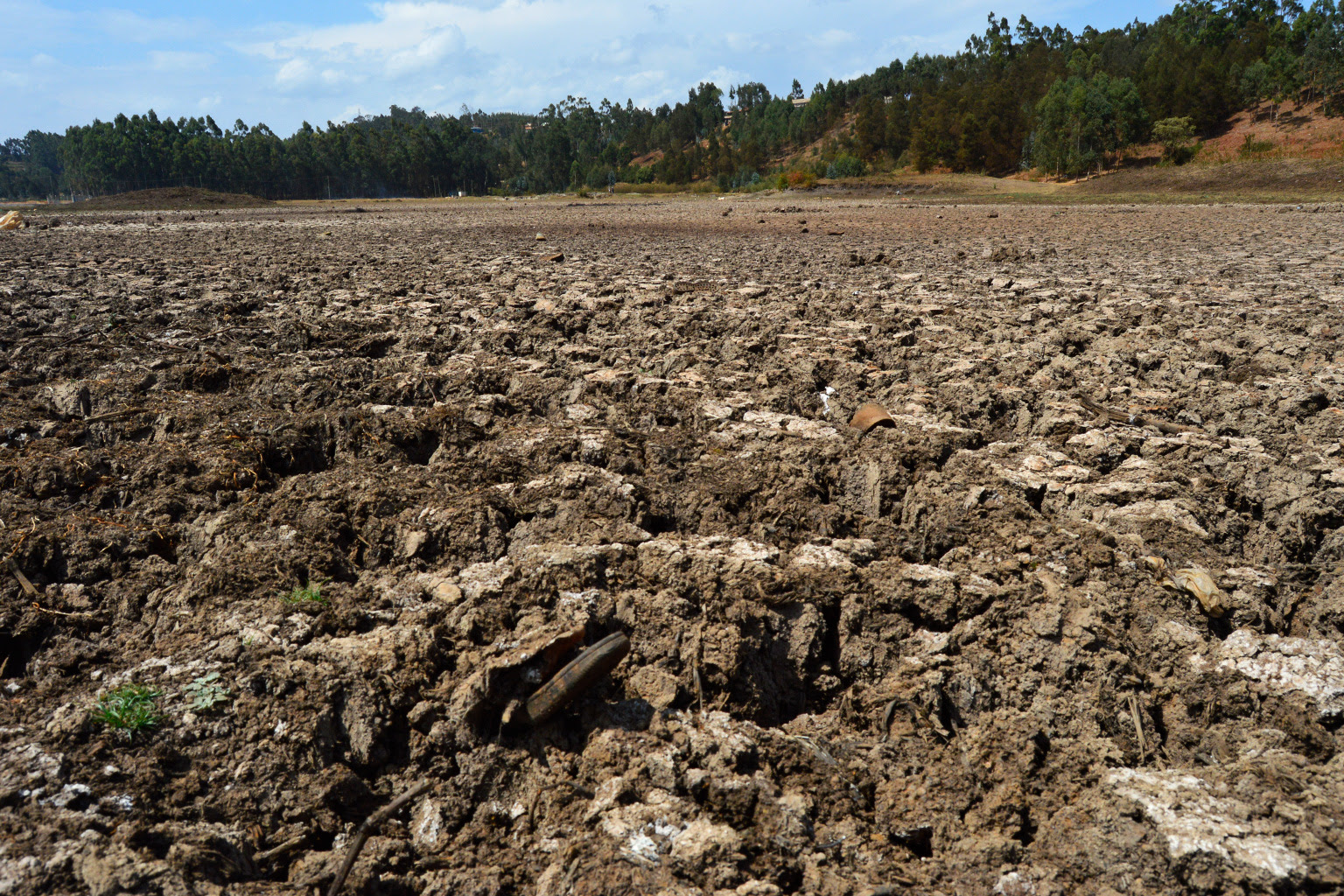 The dry earth in Manguo swamp now. Image by Calvin Rock Odhiambo/Mongabay.Meanwhile, Njuguna may be feeling the pangs of water scarcity, but George Karanja, a youthful man who approaches us as we speak, is worse off. Karanja listens for a few moments before jumping into the conversation.
The dry earth in Manguo swamp now. Image by Calvin Rock Odhiambo/Mongabay.Meanwhile, Njuguna may be feeling the pangs of water scarcity, but George Karanja, a youthful man who approaches us as we speak, is worse off. Karanja listens for a few moments before jumping into the conversation.
“When there is no water in the house, I don’t think you can stay in that house,” Karanja says, “especially with a wife and kids — the house is uninhabitable without water!” He goes on to list all the things they need water for, from sanitation to food preparation. After a short conversation, he offers to take us around the village to different water points and eventually to his home, 5 km (3.1 mi) from Manguo.
On the way to Karanja’s place, we make two stops: Bibirioni water station and Peter Mwangi’s home. Bibirioni is a privately owned water company that usually supplies water to the majority of Nyambare village residents, but when we visit, it is deserted with no sign of activity. Two steel pipes extend from one wall of a structure of about 3 meters by 2 meters (10 feet by 6.5 feet) with six plastic tanks at the top. The pipes lay dormant, their walls and surface parched and caked by dust, apparently untouched by the soft trickle of water they once carried. (As of publication, the manager of Bibirioni water company has not responded to Mongabay’s requests for comment.)
“This station hasn’t pumped water now for over six months,” Karanja says.
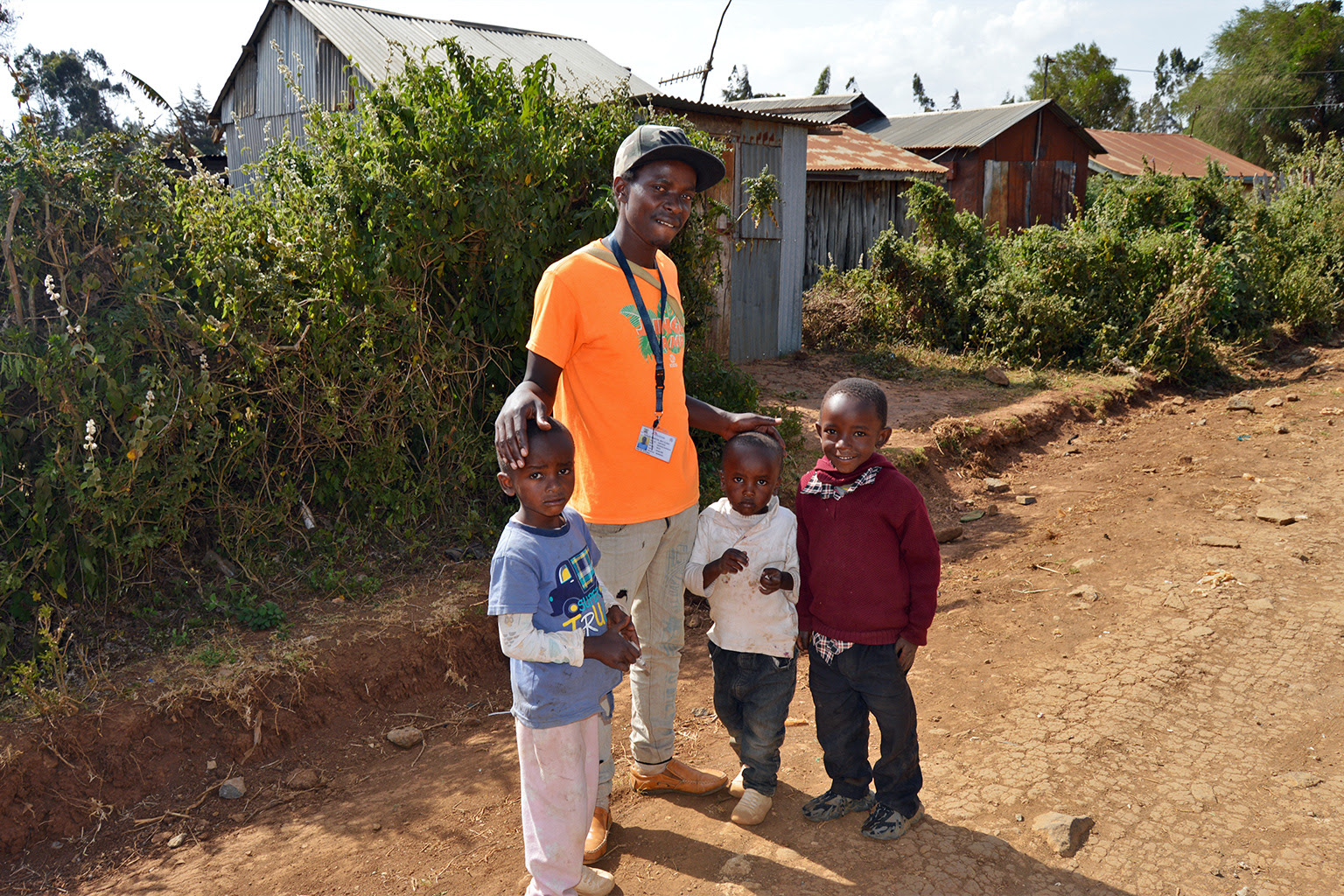 George Karanja with his children and a neighbor’s child. Image by Calvin Rock Odhiambo/Mongabay.
George Karanja with his children and a neighbor’s child. Image by Calvin Rock Odhiambo/Mongabay. Bibirioni, a privately owned water company that usually supplies water to the majority of Nyambare village residents, is deserted with no sign of activity. Image by Calvin Rock Odhiambo/Mongabay.The only other place Karanja’s family and many of the residents can get water is at Peter Mwangi’s home. Peter is among the few people in the village to have piped water supplied by Limuru water company installed at his home. Six women surround a tap while seated on water containers. Among them is Josephine Nduta, Karanja’s wife. Water trickles from the tap and the women engage in animated talk as they wait for their containers to fill.
Bibirioni, a privately owned water company that usually supplies water to the majority of Nyambare village residents, is deserted with no sign of activity. Image by Calvin Rock Odhiambo/Mongabay.The only other place Karanja’s family and many of the residents can get water is at Peter Mwangi’s home. Peter is among the few people in the village to have piped water supplied by Limuru water company installed at his home. Six women surround a tap while seated on water containers. Among them is Josephine Nduta, Karanja’s wife. Water trickles from the tap and the women engage in animated talk as they wait for their containers to fill.
“We have had water problems before, but this time it is worse than ever,” Nduta says. “Sometimes I wait almost the whole day to fetch water, but I have to wait anyway because I cannot go back without water.”
With the slow flow of water, it takes 15 minutes to fill one 20-liter (5-gallon) container. Nduta has four and has to wait at least four hours before she can fetch, since four women are ahead of her, each with four containers to fill. The water flow is not usually this slow but today it is exacerbated by a power outage.
“Every week we only get water twice, on Tuesdays and Fridays,” Nduta says. “Sometimes there is water only one day a week.” Nduta says things have become hard for her family since she spends hours at the water point, time which she could have otherwise spent working. Both she and her husband, Njuguna, depend on contractual day labor for income. Moreover, she says, some water vendors take advantage of the situation and charge more. “We normally buy a 20-liter container of water at 5 shillings [$0.04] but now we have to pay double that,” she says.
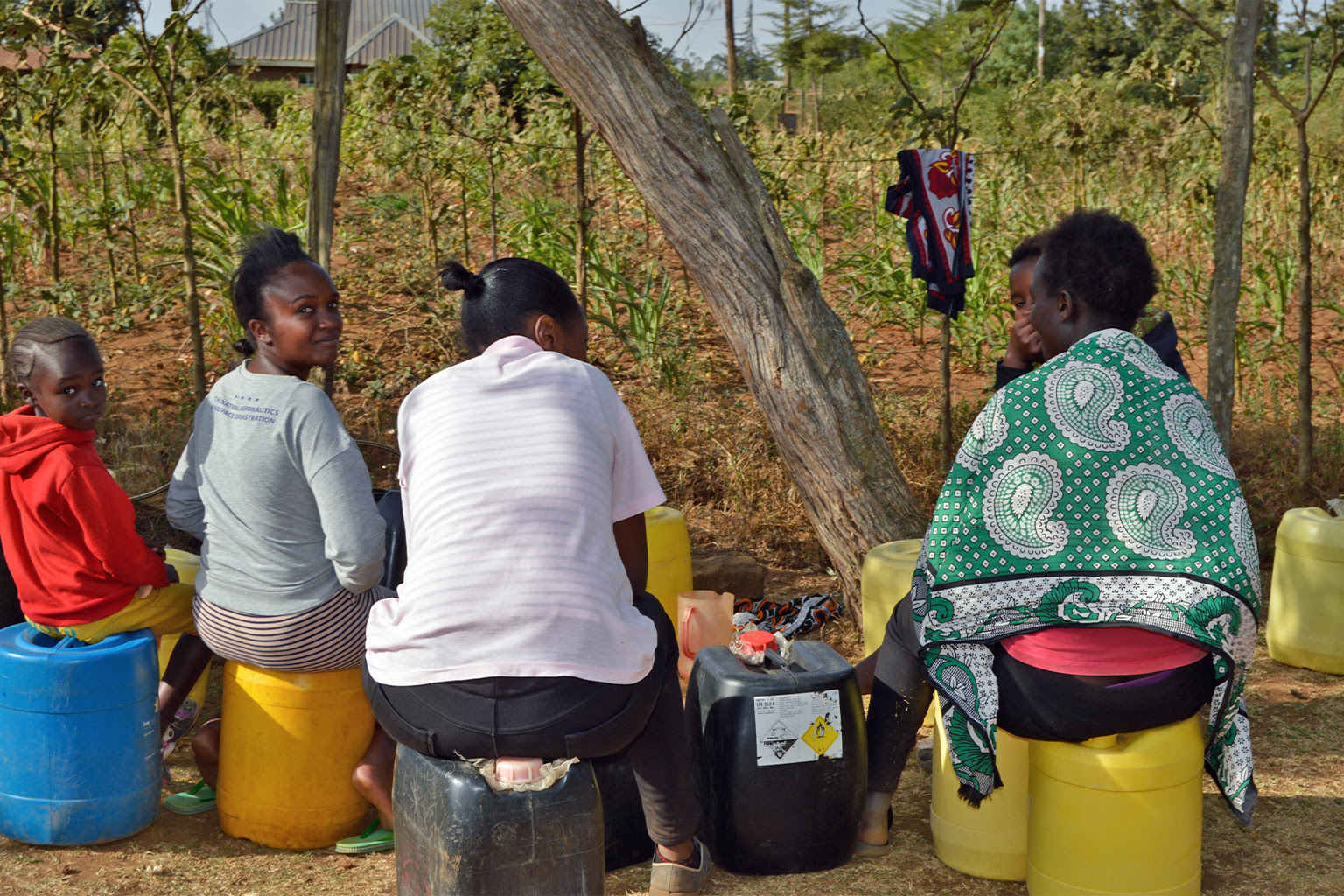 Every woman at the water point had at least four containers. Nduta had to wait over four hours for her turn to fetch water. Image by Calvin Rock Odhiambo/Mongabay.Given the water shortage, the county-run Limuru water company has no option but to ration water. This has made a dire situation worse since only a handful of people can afford to install piped water, which costs 4,500 shillings [$34] without plumbing costs. This is beyond reach for many people, given the unemployment rate in Kiambu county is 17%, according to the county website. Most of the employed work in farms, industries and quarry sites, while others like Njuguna are subsistence farmers.
Every woman at the water point had at least four containers. Nduta had to wait over four hours for her turn to fetch water. Image by Calvin Rock Odhiambo/Mongabay.Given the water shortage, the county-run Limuru water company has no option but to ration water. This has made a dire situation worse since only a handful of people can afford to install piped water, which costs 4,500 shillings [$34] without plumbing costs. This is beyond reach for many people, given the unemployment rate in Kiambu county is 17%, according to the county website. Most of the employed work in farms, industries and quarry sites, while others like Njuguna are subsistence farmers.
“This [water crisis] is a result of long-term human impact on [the] environment. … Natural phenomena [are] accelerated by human activity, then we have such phenomena like what we are having today of long and severe drought,” says David Kuria, Kiambu County Executive Committee member in charge of water, environment and natural resources. “We [humans] have turned some areas into concrete jungles,” he says. “Human population has really increased, and therefore, the need for houses; and when you have more houses, they alter the ecosystem; and therefore, when you alter the ecosystem, you affect climate and you affect nature.”
According to him, excessive air pollution, deforestation, encroachment on riparian land and pollution of water sources have accelerated climate change and worsened the effects of drought. The drought and subsequent water rationing have affected many residents of Kiambu, forcing them to go to far-flung places in search of water or pay more to get water, he says.
The primary source of water for Kiambu county is rivers originating from the southern Aberdare Forest, most of which, Kuria says, have dried. In February 2023, more than 40,000 acres of the Aberdare Forest was destroyed by wildfire, further posing serious environmental threats. According to Kuria, the situation is worrying and he says only the rains could make things better.
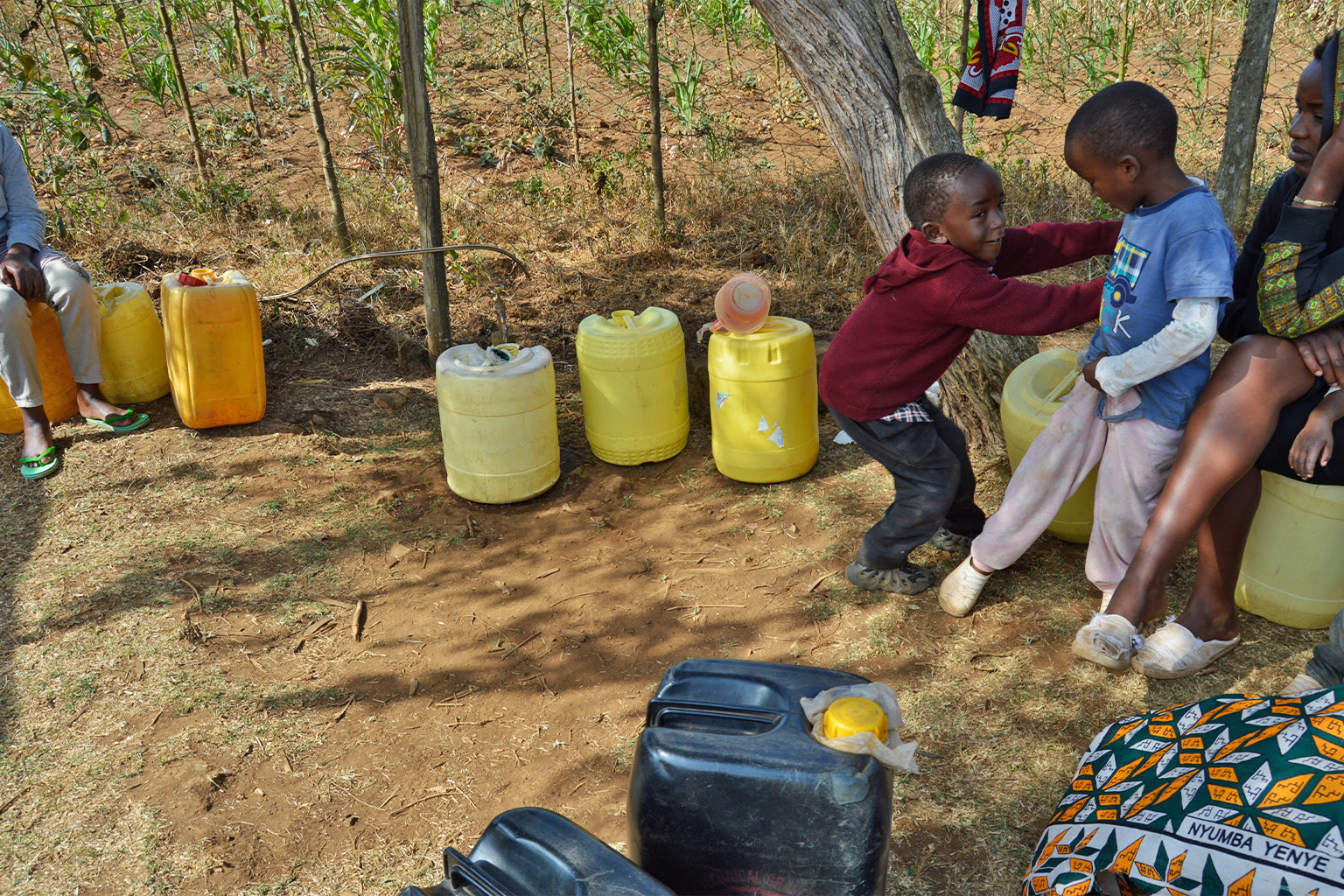 The Karanja children play as their mother waits for her turn to fetch water. Image by Calvin Rock Odhiambo/Mongabay.With the onset of the long-rains season, the Kenya Meteorological Department forecasts that much of the country is likely to receive near-average rainfall. But this comes on the heels of the sixth consecutive failed rainy season in the Horn of Africa and many parts of Kenya, and it’s unclear how this season will affect the long-term health of the country’s waterways.
The Karanja children play as their mother waits for her turn to fetch water. Image by Calvin Rock Odhiambo/Mongabay.With the onset of the long-rains season, the Kenya Meteorological Department forecasts that much of the country is likely to receive near-average rainfall. But this comes on the heels of the sixth consecutive failed rainy season in the Horn of Africa and many parts of Kenya, and it’s unclear how this season will affect the long-term health of the country’s waterways.
On March 22, Kenya joined the world in celebrating the U.N.-designated World Water Day, but with little to celebrate given the extended water crisis in parts of the country.
“As a government, we are rationing water and encouraging people to share the available water and also use water sparingly in a sustainable way,” says Kuria. He asserts that conservation measures, including securing water sources and planting trees, could help alleviate the water crisis in the long term. Moreover, innovative methods of water harvesting, such as retention dams, which store water over long periods, would help in ensuring water security during dry seasons.
Macharia echoes Kuria’s sentiments, explaining that the effects of drought are a result of human activities contributing to climate change. As a solution, she emphasizes creating awareness about conservation efforts among local communities, since the benefits of natural resources to them and the ecosystem are not always clear. She supports sustainable agriculture practices, which involve cultivating away from wetlands to avoid siltation, which makes the wetlands shallow and prone to drying up.
Human beings must be at the center of restoration efforts, she says, quoting the late Kenyan nobel laureate and conservationist Wangari Maathai: Nature is “unforgiving.”
Mogabay

Hello world!
Equity Bank Plan Sh7.6b Staff Share Reward Scheme
Fish kills leave Kenya’s Lake Victoria farmers at a loss, seeking answers

These ’90s fashion trends are making a comeback in 2017
Dr. Gideon Muriuki: Kenya’s Banking Contrarian With a Panache For Pulling Ground Breaking Surprises
Dr. Manu Chandaria: East Africa’s No.1 Philanthropist Indelibly Secures an Unvarnished Legacy
Trending
-

 Fashion7 years ago
Fashion7 years agoThese ’90s fashion trends are making a comeback in 2017
-
Uncategorized1 year ago
Dr. Gideon Muriuki: Kenya’s Banking Contrarian With a Panache For Pulling Ground Breaking Surprises
-
Uncategorized1 year ago
Dr. Manu Chandaria: East Africa’s No.1 Philanthropist Indelibly Secures an Unvarnished Legacy
-
Uncategorized1 year ago
Kenyan Billionaire Once Ranked 41 Richest Black Man in the US Emerges From Retirement
-
Uncategorized1 year ago
Former World Bank Contractor Making Waves as a Fashionista
-
Uncategorized1 year ago
Nelson C. Kuria- Kenya’s Insurance Oracle Has Come Along Way And Is Back Home
-
Uncategorized1 year ago
Abel Mutua: Mastering Storytelling
-
Uncategorized1 year ago
Safaricom Replaces Former President Kenyatta’s ally as Board Chairman.
